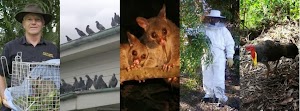1. ANIMAL DESCRIPTION
Common name: Common Starling
Scientific name: Sturnus vulgaris
Classed as an invasive species in Australia
SIZE AND WEIGHT
The fully grown adult is between 190 to 220 mm long. The weight of an adult ranges from 380 to 800 grams.
FEATURES
The common starling is a small to medium-sized bird. Their plumage is generally a glossy black feather with an iridescent green and purple sheen. Both males and females look very similar in their appearance and would be hard to distinguish to the untrained eye.
They gain new feathers after moulting in the autumn months. For adults, the new feathers have pale coloured tips which give the common starling a spotted or speckled visual appearance. By the time Spring has arrived the speckled feathers have matured and the normal glossy green/purple sheen of the feathers has appeared. Immature starlings have a light brown plumage until the first Autumn season approaches and they then moult and develop the full adult plumage of black and brown with bright yellow legs.
Their beak is also another feature of its body that changes colour seasonally. During the breeding season the beak will change to a yellow colour while the majority of the year it appears a dull black colour.
2. ECOLOGY AND BEHAVIOUR
The common starling was imported into Australia during the 1860’s from Europe. It has become classified as an invasive species due to its prolific breeding and the environmental damage it causes. It is in the same category as the cane toad and the Indian Mynah bird – a species introduced into Australia to control a native pest but upon release the population exploded to the detriment of the local native Australian flora and fauna.
The Australian populations do not behave like their European counter parts. While the European populations are subject to wide scale seasonal migrations in large numbers, the Australian version does not undertake these mass movements.
The birds are in many urban areas but also occur in open woodland areas, irrigated pastures and livestock feedlots. They have also successfully inhabited the mulga and mallee regions and can be found in wetland areas. They are prolific in coastal plain areas but not so common in the highland and alpine areas. The common starling avoids areas such as dense woodlands, forests and arid regions. The availability of water appears to be important to the common starling’s survival. Areas of high rainfall and irrigated areas including those with temporary surface water and flooded swamps can support high densities of the common starling.
They will move around to find abundant food sources in smaller regional areas. The cultivation and subsequent harvesting of agricultural crops does have a large bearing on their movements. The younger starlings can migrate up to 2000 kilometres after they have left their initial flock to find and establish their own territory and flocks.
Interestingly they have failed to populate the very suitable habitat of south west Western Australia probably due to the barrier to migration created by the Nullarbor Plains. It seems all the arid desert regions act as natural barriers to their migration.
The typical start to a starling’s day involves a mass departure from their night-time roosts, of up to 25,000 birds shortly after first light. They then disperse into smaller groups to varied feeding areas. Normally they will feed within 2 kilometres of their evening roost position but will travel up to 80 kilometres to find suitable food.
During the seasons of Autumn and Winter they form their largest flocks and leave their roosting areas earlier in the morning because they will travel further distances to find feeding sites. Their movements focus primarily on feeding areas so they will change their roosting locations to suit the available food sources.
It has been observed and recorded that starlings require a substantial amount of protein in their diets to live and breed successfully.
They also consume a wide variety of fruits, berries, seed grain, freshly ploughed seeds in paddocks, vegetables, meat and food scraps and livestock feed. But their diet consists of a lot of invertebrates (insects, worms and grubs) which comprises over half their daily food intake. They are generally ground feeders and will utilize their beaks to probe the soil for insects and bugs.
BREEDING
Starlings are seasonal breeders, breeding from July to March with a peak of activity in August and September. They form pairs and nest in tree hollows, building cavities, holes in the ground and gaps or crevices in cliffs. They also nest in shrubs and trees but seem to prefer to get inside cavities, such as holes in tree trunks and stumps or, in urban areas, any gaps in the roof or gutter of a building.
Both parents help to build the nest and incubate the eggs. They will both share the duties in feeding their young and raising them. Starlings produce 2 to 3 broods a year and produce on average 4 to 6 eggs with each brood. The eggs are a light blue colour and are laid in a nest made from straw, twigs, leaves and feathers. The incubation period of the eggs is around 12 days and the young take anywhere from 14 to 21 days to fledge before they leave the nest.
3. HOME OWNER PROBLEMS
Starlings can carry a serious fungal disease that affects the human respiratory system named histoplasmosis. The fungus strain called Histoplasma capsulatum can propagate in the soils found directly under bird roosts. In dry weather the spores become airborne especially when the soil beneath the nesting site is disturbed. Histoplasmosis can cause blindness and death in human beings but this is not a common occurrence.
They also carry various types of parasites and diseases. They have been directly linked with diseases such as Salmonella and Cryptococci. Commonly these diseases have the biggest impact on industrial food factories but they can also cause problems for the livestock industry. Starlings have been linked to Newcastle Disease (a virus affecting poultry) and transmissible gastroenteritis in pigs. The spread of diseases can be potentially dangerous to household family pets.
Environmentally if home owners care about the abundance of Australian native wild bird life in their gardens and surrounds, then the birds can have a massive negative impact. Their aggressive competition for limited nesting hollows forces the Australian birdlife out of their homes and the population of the Australian birds begins to dwindle as they cannot compete for food or breeding opportunities.
They are considered to be a major nuisance in urban areas due to their excessive numbers, the noise from large flocks and the mess they create. Home owners find them nesting under roofs. They can also infest people’s homes with bird lice and raise the risk of the diseases listed above. Home owners are also affected by Starlings when they nest and roost en masse in local parklands and shopping centres. They are extremely noisy and can contaminate the areas under the roost and neighbouring homes with their unpleasant droppings. The Starling’s droppings are acidic and corrosive which can damage houses and vehicles parked near their nesting points. The odour is unpleasant when droppings are allowed to build up in quantity around people’s homes. No home owner appreciates this mess and smell.
4. SUMMARY – HOW CAN PETER THE POSSUM MAN HELP YOU?
Apart from excessive noise at dusk when the birds might be nesting in your home’s eaves, they bring with them unwanted risk of bird lice and possibly bird diseases as well as the damage to property and paint work from their acidic droppings. This is not good when you are trying to protect your biggest investment – your house.
Your family’s health is the highest priority so locating a professional and reputable eco-friendly pest controller to remove the Starlings bird nest is essential. By acting quickly and contacting Peter the Possum & Bird Man who specializes in removing birds from inside buildings, you can prevent expensive damage to your home.
Call Peter the Possum & Bird Man and ask for the friendly serviceman who is the Brisbane bird removal specialist. Our highly trained pest controllers and bird controllers will attend to your unwanted Starling flock promptly and efficiently. We have over 25 years of experience and we know all of the animal friendly techniques on how to remove unwanted birds today, including bird spikes and bird netting.
We will repair and modify your house’s susceptible entry points or install bird netting for Starling proofing as well. So not only do you say good bye and get rid of the Starling as an unwanted guest but your house is also repaired and made Starling proof for future unwanted entry.
You benefit from not having to deal with the potential parasites and air borne diseases the Starlings carry. You do not have to crawl up into the roof space.







